North Carolina is a great birding state!
There have been approximately 481 recorded species in North Carolina. Some are seasonal, but many stay year round
The State Bird 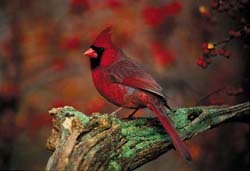
In 1943, the Northern Cardinal was accepted as North Carolina’s state bird. It is also stated as the Winter Redbird as one mostly finds it in the cold season. Similarly, it is the only bird having a clear red color throughout that time. The male bird is almost entirely red, excluding its beak and throat with black color. Female Cardinals have a sharp crest and warm red accents. Cardinals don’t migrate and they don’t molt into a dull plumage, so they’re still breathtaking in winter’s snowy backyards. In summer, their sweet whistles are one of the first sounds of the morning. Nearly any bird feeder you put out ought to attract Northern Cardinals (as long as you live within their range), but they particularly seem to use sunflower seeds and safflower. Leave undergrowth in your backyard or around the edges, and you may have cardinals nesting on your property.
Some Common Backyard Birds in Western North Carolina
Downy Woodpecker 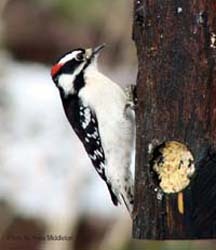
The Downy Woodpecker is a black and white woodpecker. The male will have a red patch on the back of his head. These Woodpeckers are often seen in backyards, parks, and woodlots. Woodpeckers don’t sing songs, they drum. In the winter Downy Woodpeckers like to hang out with other birds, such as the Nuthatch and Chickadee. They like suet, sunflower seeds, peanuts, and Bark Butter.
Brown Thrasher 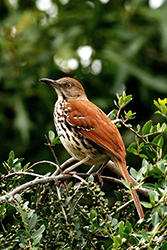
The Brown Thrasher is the only bird in the thrasher species that lives east of Texas. They are secretive birds, hiding in shrubs. The Brown Thrasher is a large, brown songbird with long legs, a long tail, and yellow eyes. Brown Thrashers are exuberant singers, with one of the largest repertoires of any North American songbird. Brown Thrashers may come to backyards if food is offered. Sometimes they visit feeders or the ground below to pick up fallen seed. There is a better chance they will visit if dense cover is close by. You can also attract them by planting shrubs that produce berries.
Northern Mockingbird 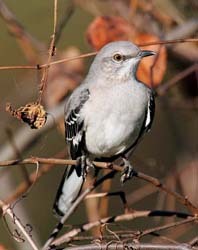
The Northern Mockingbird is found throughout the United States. It is a gray bird with a white underbelly and black and white wings. They are common in backyards, hopping along a fresh-cut lawn. They sing almost endlessly, even sometimes at night, and they flagrantly harass birds that intrude on their territories, flying slowly around them or prancing toward them, legs extended, flaunting their bright white wing patches. While the Northern Mockingbird is common in backyards, they don’t often visit feeders. You can encourage mockingbirds to visit your yard by keeping an open lawn but providing fruiting trees or bushes, including mulberries, hawthorns, and blackberry brambles.
Chipping Sparrow 
Chipping Sparrows have a bright brown crown on the top of their head, a black eyeline, and are grayish underneath. Their wings are streaked dark and light brown with a wingbar. They are seen throughout the U.S. They can be seen in trees and grassy areas and like to make their homes in open woods, orchards, and other farmlands. This species often comes to bird feeders. Chipping Sparrows will eat many kinds of birdseed, particularly black oil sunflower seeds from feeders, but also seed mixes scattered on the ground. Shrubs or small trees in your yard may entice Chipping Sparrows to build a nest.
Blue Jay 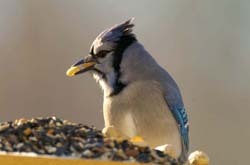
This common, large songbird is familiar to many people, with its perky crest; blue, white, and black plumage; and noisy calls. Blue Jays are known for their intelligence and complex social systems with tight family bonds. Their fondness for acorns is credited with helping spread oak trees after the last glacial period. Blue Jays prefer tray feeders or hopper feeders on a post rather than hanging feeders, and they prefer peanuts, sunflower seeds, and suet. Planting oak trees will make acorns available for jays of the future. Blue Jays often take drinks from birdbaths.
Carolina Wren 
This shy bird can be hard to see, but it delivers an amazing number of decibels for its size. Follow its "teakettle-teakettle!" and other piercing exclamations through backyard or forest, and you may be rewarded with glimpses of this bird's rich cinnamon plumage, white eyebrow stripe, and long, upward-cocked tail. This hardy bird has been wintering farther and farther north in recent decades. Carolina Wrens often come to backyards if food is available and will visit your suet-filled feeders in winter. During cold northern winters, these wrens will take shelter in nest boxes containing dried grasses, particularly boxes with slots rather than holes. In spring, they may nest in boxes, but they're just as likely to choose a hanging fern or an empty flower pot tucked away in a quiet corner of an overgrown backyard.
White Breasted Nuthatch 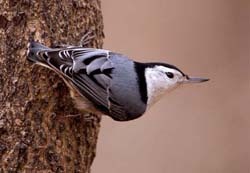
A common feeder bird with clean black, gray, and white markings, White-breasted Nuthatches are active, agile little birds with an appetite for insects and large, meaty seeds. They get their common name from their habit of jamming large nuts and acorns into tree bark, then whacking them with their sharp bill to “hatch” out the seed from the inside. White-breasted Nuthatches may be small but their voices are loud. In winter, White-breasted Nuthatches join foraging flocks led by chickadees or titmice, perhaps partly because it makes food easier to find and partly because more birds can keep an eye out for predators. One study found that when titmice were removed from a flock, nuthatches were more wary and less willing to visit exposed bird feeders.
Tufted Titmouse 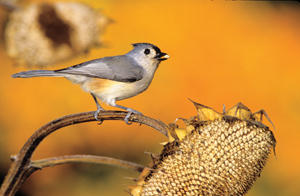
A little gray bird with an echoing voice, the Tufted Titmouse is common in eastern deciduous forests and a frequent visitor to feeders. The large black eyes, small, round bill, and brushy crest gives these birds a quiet but eager expression that matches the way they flit through canopies, hang from twig-ends, and drop in to bird feeders. When a titmouse finds a large seed, you’ll see it carry the prize to a perch and crack it with sharp whacks of its stout bill. Tufted Titmouse are regulars at backyard bird feeders, especially in winter. They prefer sunflower seeds but will eat suet, peanuts, and other seeds as well. Tufted Titmice hoard food in fall and winter, taking advantage of a bird feeder’s bounty by storing many of the seeds they get. Usually, the storage sites are within 130 feet of the feeder. The birds take only one seed per trip and usually shell the seeds before hiding them.
Eastern Bluebird 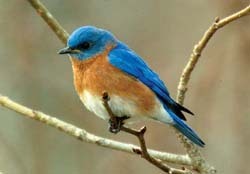
Male Eastern Bluebirds are a brilliant royal blue on the back and head, and warm red-brown on the breast. Blue tinges in the wings and tail give the grayer females an elegant look. This species may visit backyards if food is offered. It doesn't often come to feeders, unless you have feeders that provide mealworms. Eastern Bluebirds are a great prospect for nest boxes if you have the space to put one up in your yard, and if your yard isn’t too hemmed in by trees or houses. Consider putting up a nest box to attract a breeding pair. Make sure you put it up well before breeding season. Attach a guard to keep predators from raiding eggs and young. The male Eastern Bluebird displays at his nest cavity to attract a female. He brings nest material to the hole, goes in and out, and waves his wings while perched above it. That is pretty much his contribution to nest building; only the female Eastern Bluebird builds the nest and incubates the eggs.
American Goldfinch 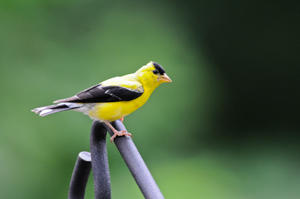
This handsome little finch is welcome and common at feeders, where it takes primarily sunflower and nyjer. Goldfinches often flock with Pine Siskins and Common Redpolls. Spring males are brilliant yellow and shiny black with a bit of white. Females and all winter birds are more dull but identifiable by their conical bill; pointed, notched tail; wingbars; and lack of streaking. During molts they look bizarrely patchy. American Goldfinches are unusual among goldfinches in molting their body feathers twice a year, once in late winter and again in late summer. The brightening yellow of male goldfinches each spring is one welcome mark of approaching warm months. To encourage goldfinches into your yard, plant native thistles and other composite plants, as well as native milkweed. Almost any kind of bird feeder may attract American Goldfinches, including hopper, platform, and hanging feeders, and these birds don’t mind feeders that sway in the wind. You’ll also find American Goldfinches are happy to feed on the ground below feeders, eating spilled seeds.
Carolina Chickadee 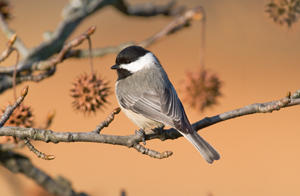
John James Audubon named this bird while he was in South Carolina. The curious, intelligent Carolina Chickadee looks very much like a Black-capped Chickadee, with a black cap, black bib, gray wings and back, and whitish underside. Carolina Chickadees visit feeders for sunflower seeds, peanut chips, and suet. Make sure any peanuts you provide stay dry so no mold can form on them. Consider putting up a nest box to attract a breeding pair. Make sure you put it up well before breeding season. Attach a guard to keep predators from raiding eggs and young. In winter, Carolina Chickadees live in flocks of two to eight birds and defend areas against other flocks. Dominant birds in these flocks establish breeding territories in the summer that were part of the winter flock's range.
Eastern Towhee 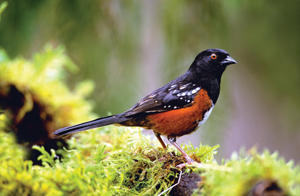
A strikingly marked, oversized sparrow of the East, feathered in bold black and warm reddish-browns. Eastern Towhees are birds of the undergrowth, where their rummaging makes far more noise than you would expect for their size. This species often comes to bird feeders. Eastern Towhees are likely to visit – or perhaps live in – your yard if you’ve got brushy, shrubby, or overgrown borders. If your feeders are near a vegetated edge, towhees may venture out to eat fallen seed.
Red-winged Blackbird 
One of the most abundant birds across North America, and one of the most boldly colored, the Red-winged Blackbird is a familiar sight atop cattails, along soggy roadsides, and on telephone wires. Glossy-black males have scarlet-and-yellow shoulder patches they can puff up or hide depending on how confident they feel. Females are a subdued, streaky brown, almost like a large, dark sparrow. Their early and tumbling song are happy indications of the return of spring. Spread grain or seed on the ground, since this is where Red-winged Blackbirds prefer to feed.
House Finch 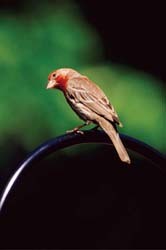
The House Finch is a recent introduction from western into eastern North America (and Hawaii), but it has received a warmer reception than other arrivals like the European Starling and House Sparrow. That’s partly due to the cheerful red head and breast of males, and to the bird’s long, twittering song, which can now be heard in most of the neighborhoods of the continent. Fill your backyard feeders with small, black oil sunflower seed. If House Finches discover your feeders, they might bring flocks of 50 or more birds with them.
These are just a few of the birds you may see in your backyard or while exploring Western North Carolina. For a more comprehensive list, stop into Wild Birds Unlimited in Hendersonville and check out our selection of books and field guides.

